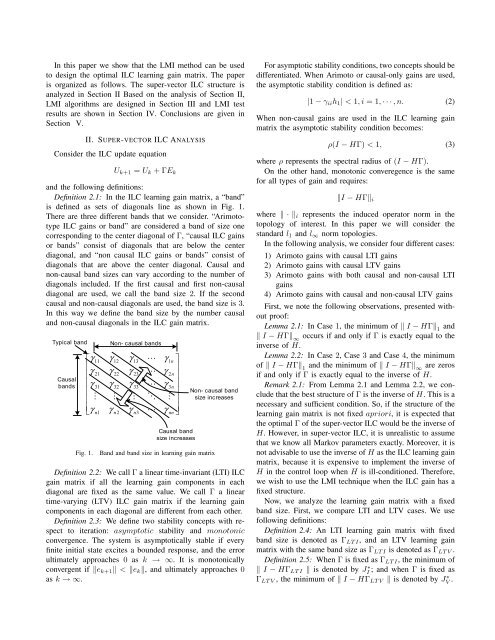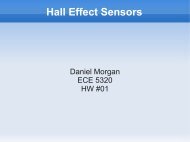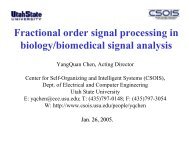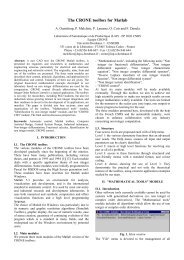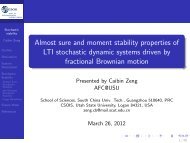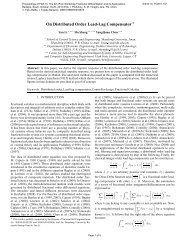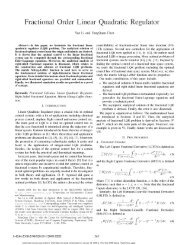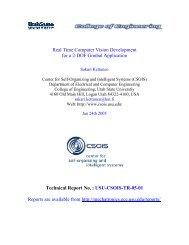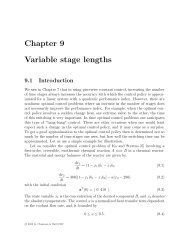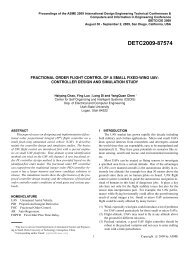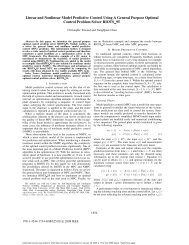LMI Approach to Iterative Learning Control Design - ResearchGate
LMI Approach to Iterative Learning Control Design - ResearchGate
LMI Approach to Iterative Learning Control Design - ResearchGate
Create successful ePaper yourself
Turn your PDF publications into a flip-book with our unique Google optimized e-Paper software.
In this paper we show that the <strong>LMI</strong> method can be used<br />
<strong>to</strong> design the optimal ILC learning gain matrix. The paper<br />
is organized as follows. The super-vec<strong>to</strong>r ILC structure is<br />
analyzed in Section II Based on the analysis of Section II,<br />
<strong>LMI</strong> algorithms are designed in Section III and <strong>LMI</strong> test<br />
results are shown in Section IV. Conclusions are given in<br />
Section V.<br />
II. SUPER-VECTOR ILC ANALYSIS<br />
Consider the ILC update equation<br />
Uk+1 = Uk + ΓEk<br />
and the following definitions:<br />
Definition 2.1: In the ILC learning gain matrix, a “band”<br />
is defined as sets of diagonals line as shown in Fig. 1.<br />
There are three different bands that we consider. “Arimo<strong>to</strong>type<br />
ILC gains or band” are considered a band of size one<br />
corresponding <strong>to</strong> the center diagonal of Γ, “causal ILC gains<br />
or bands” consist of diagonals that are below the center<br />
diagonal, and “non causal ILC gains or bands” consist of<br />
diagonals that are above the center diagonal. Causal and<br />
non-causal band sizes can vary according <strong>to</strong> the number of<br />
diagonals included. If the first causal and first non-causal<br />
diagonal are used, we call the band size 2. If the second<br />
causal and non-causal diagonals are used, the band size is 3.<br />
In this way we define the band size by the number causal<br />
and non-causal diagonals in the ILC gain matrix.<br />
Typical band<br />
Causal<br />
bands<br />
⎡γ<br />
⎢<br />
⎢<br />
γ<br />
⎢γ<br />
⎢<br />
⎢ M<br />
⎢<br />
⎣γ<br />
n<br />
11<br />
21<br />
31<br />
1<br />
γ<br />
γ<br />
γ<br />
γ<br />
Non- causal bands<br />
12<br />
22<br />
32<br />
M<br />
n2<br />
γ<br />
γ<br />
γ<br />
γ<br />
13<br />
23<br />
33<br />
M<br />
n3<br />
L<br />
L<br />
L<br />
O<br />
L<br />
γ 1n<br />
⎤<br />
γ<br />
⎥<br />
2n<br />
⎥<br />
γ ⎥ 3n<br />
⎥<br />
M ⎥<br />
γ ⎥<br />
nn ⎦<br />
Causal band<br />
size increases<br />
Non- causal band<br />
size increases<br />
Fig. 1. Band and band size in learning gain matrix<br />
Definition 2.2: We call Γ a linear time-invariant (LTI) ILC<br />
gain matrix if all the learning gain components in each<br />
diagonal are fixed as the same value. We call Γ a linear<br />
time-varying (LTV) ILC gain matrix if the learning gain<br />
components in each diagonal are different from each other.<br />
Definition 2.3: We define two stability concepts with respect<br />
<strong>to</strong> iteration: asymp<strong>to</strong>tic stability and mono<strong>to</strong>nic<br />
convergence. The system is asymp<strong>to</strong>tically stable if every<br />
finite initial state excites a bounded response, and the error<br />
ultimately approaches 0 as k → ∞. It is mono<strong>to</strong>nically<br />
convergent if ek+1 < ek, and ultimately approaches 0<br />
as k → ∞.<br />
For asymp<strong>to</strong>tic stability conditions, two concepts should be<br />
differentiated. When Arimo<strong>to</strong> or causal-only gains are used,<br />
the asymp<strong>to</strong>tic stability condition is defined as:<br />
|1 − γiih1| < 1, i = 1, · · · , n. (2)<br />
When non-causal gains are used in the ILC learning gain<br />
matrix the asymp<strong>to</strong>tic stability condition becomes:<br />
ρ(I − HΓ) < 1, (3)<br />
where ρ represents the spectral radius of (I − HΓ).<br />
On the other hand, mono<strong>to</strong>nic converegence is the same<br />
for all types of gain and requires:<br />
I − HΓi<br />
where · i represents the induced opera<strong>to</strong>r norm in the<br />
<strong>to</strong>pology of interest. In this paper we will consider the<br />
standard l1 and l∞ norm <strong>to</strong>pologies.<br />
In the following analysis, we consider four different cases:<br />
1) Arimo<strong>to</strong> gains with causal LTI gains<br />
2) Arimo<strong>to</strong> gains with causal LTV gains<br />
3) Arimo<strong>to</strong> gains with both causal and non-causal LTI<br />
gains<br />
4) Arimo<strong>to</strong> gains with causal and non-causal LTV gains<br />
First, we note the following observations, presented without<br />
proof:<br />
Lemma 2.1: In Case 1, the minimum of I − HΓ1 and<br />
I − HΓ∞ occurs if and only if Γ is exactly equal <strong>to</strong> the<br />
inverse of H.<br />
Lemma 2.2: In Case 2, Case 3 and Case 4, the minimum<br />
of I − HΓ1 and the minimum of I − HΓ∞ are zeros<br />
if and only if Γ is exactly equal <strong>to</strong> the inverse of H.<br />
Remark 2.1: From Lemma 2.1 and Lemma 2.2, we conclude<br />
that the best structure of Γ is the inverse of H. This is a<br />
necessary and sufficient condition. So, if the structure of the<br />
learning gain matrix is not fixed apriori, it is expected that<br />
the optimal Γ of the super-vec<strong>to</strong>r ILC would be the inverse of<br />
H. However, in super-vec<strong>to</strong>r ILC, it is unrealistic <strong>to</strong> assume<br />
that we know all Markov parameters exactly. Moreover, it is<br />
not advisable <strong>to</strong> use the inverse of H as the ILC learning gain<br />
matrix, because it is expensive <strong>to</strong> implement the inverse of<br />
H in the control loop when H is ill-conditioned. Therefore,<br />
we wish <strong>to</strong> use the <strong>LMI</strong> technique when the ILC gain has a<br />
fixed structure.<br />
Now, we analyze the learning gain matrix with a fixed<br />
band size. First, we compare LTI and LTV cases. We use<br />
following definitions:<br />
Definition 2.4: An LTI learning gain matrix with fixed<br />
band size is denoted as ΓLT I, and an LTV learning gain<br />
matrix with the same band size as ΓLT I is denoted as ΓLT V .<br />
Definition 2.5: When Γ is fixed as ΓLT I, the minimum of<br />
I − HΓLT I is denoted by J ∗ I ; and when Γ is fixed as<br />
ΓLT V , the minimum of I − HΓLT V is denoted by J ∗ V .


